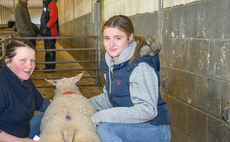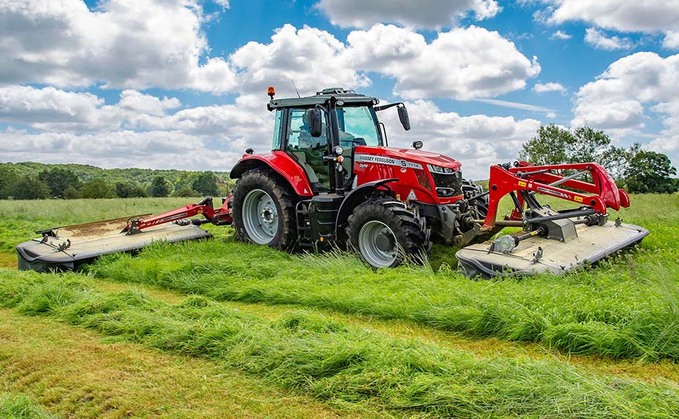
Keen to find out more about Massey Ferguson's latest tractor developments and technology changes, we put to the test its latest 6718 S and 7718 S models. James Rickard reports.
While much of Massey Ferguson's latest marketing efforts have centred around the launch of its new 8S tractor series, replacing the long wheelbase 7700 S Series, the firm has still been busy developing its other tractor ranges.
In particular, the manufacturer has made great strides in technology additions, with the introduction of its new Datatronic 5 and Fieldstar 5 touch screen terminals. To find out more about this and how the tractors have evolved in the last couple of years, we got our hands on the manufacturer's latest 6700 S and short wheelbase 7700 S tractors.
As two of the most popular models from MF, our brace of test machines consisted of a four-cylinder 6718 S and a six-cylinder 7718 S. Both tractors are in the region of 180hp (maximum rated power), with the 6718 S boosting to 200hp and the 7718 S to 210hp, and both were fitted with the firm's Dyna-6, semi-powershift gearbox, offering 24 gears in four ranges.
To put the tractors into context, the 6718 S is part of a five model range and represents the manufacturer's most powerful four-cylinder. Similarly, the 7718 S is part of the firm's four-model, short wheelbase 7700 S range, sitting just below the flagship 7719 S.
In both ranges, due to lack of uptake in the UK and Ireland, the smallest 6712 S and 7714 S models have now been dropped, as has its Dyna-4, 16-speed, semi-powershift gearbox option, leaving customers with a choice of the Dyna-6 or Dyna-VT continuously variable transmissions.
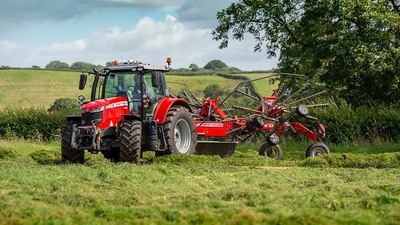
Technology developments
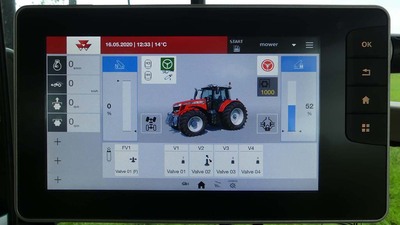
With the old Datatronic 4 terminal stretched to its limits, MF recently introduced its new, fifth generation Datatronic 5 and Fieldstar 5 terminals to the 6700 S and 7700 S Series.
Featuring nine inch touch screens, they completely transform the way the tractors can be set up. While the old Datatronic 4 had plenty of features and functions, it had become awkward to use, with only a rotary dial for navigation and more layers than an onion to dig through.
With the new terminals, usability has been well thought about, with clear icons, simple navigation and very few layers.
Both new terminals can look after guidance, section control, IsoBus control, MultiPad button assignment, the ability to view a camera, and documentation, while Datatronic 5 adds the capability to set up all tractor functions such as spools, transmission and engine characteristics. The latter is on top of the ability to setup tractor functions through the dash, in particular the transmission, as you could before.
Ultimately, this means you can pretty much spec the tractors to how you like them, with the ability to have no terminals, one terminal or both. For instance, if you wanted a basic tractor, but wanted guidance and section control for fertiliser spreading, you could just go for the Fieldstar 5; if the need to have more control over electric spools was important, Datatronic 5 could be specified; or if you simply wanted a second screen to monitor an IsoBus implement, then both screens could be useful.
Our two test tractors meant we had one of each, allowing us to explore the differences. Screens are mounted on rails on the right hand side of the cab, allowing you to almost put them where you want.
Technology developments 2
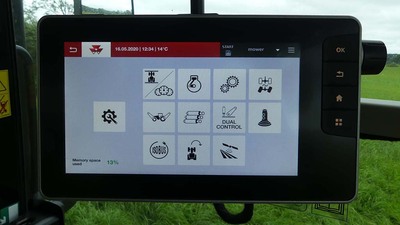
On top of the addition of touchscreen technology, there is a few more functions added. However, it is the much simpler navigation and easier usability which really stands out. With iPad-like control, it is very smooth and responsive - a shear world away from Datatronic 4.
From start up, Datatronic 5 greets you with a simple home screen featuring an image of the tractor and all of its main parameters such as linkage position and spool valve status. Any one of these parameters can then be tapped and adjusted.
To the left of the main image is a column of easily customised key information. This can be anything from forward speed to wheelslip levels.
From this home screen you can swipe left or right to three main other screens; IsoBus, guidance or video screen. This gives you a quick route to key functions without having to go through any layers.
Once in any of the four screens, a menu button can be pressed from where all functions can be setup and adjusted. It really is very simple to fathom; see it, press it, adjust it. Physical controls on the right hand side of the screen also allow an alternative to touchscreen navigation, which is useful when on the move.
Finally, if you want to see more at once, the screen can be split in two and it features day and night modes with an automatic dimming function. Glare off the sun never seemed to be an issue either.
Terminal capability
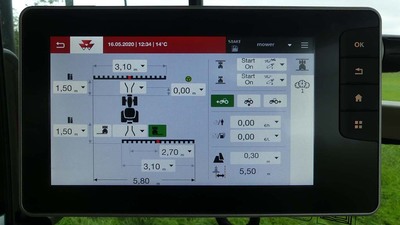
As for areas where the new terminals are a whole lot easier to use, tractor setup and headland management stand out. The former means you do not have to go through the dash to adjust areas like the transmission, which has a wide variety of setting. Now, via one page, you can set upper gear preferences for the automatic modes, start off gears, shuttle aggression, transmission aggression, and turn on/off features like ‘brake to neutral'.
Likewise, it is now a lot more tempting to set a proper headland management sequence, compared to Dataronic 4 where it was so fiddly you would just give up and drive it manually. Now, it is a case of just a few taps and you are done.
In the guidance screen, a lot of work has been done to simplify setup. In particular, inputting implement dimensions, type and its position relative to the tractor is a lot easier, helped by the clear graphics. Also, the ability to input a front implement and a rear implement independently, with the tractor working out things like the offset of a centre line is very useful. Scarily, you can also input fuel costs, with the tractor giving a live reading of how much a job is costing.
In addition, a whole host of new wayline types offer greater flexibility. A new favourite of ours is a ‘direction' wayline, which, from a stationary position, creates waylines based on the direction the tractor is pointing - ideal if you are working in an odd-shaped field and do not have a straight headland to work from. Guidance also takes into account the use of trailed implements, which in many cases means you will not need a second receiver.
Terminal capability 2
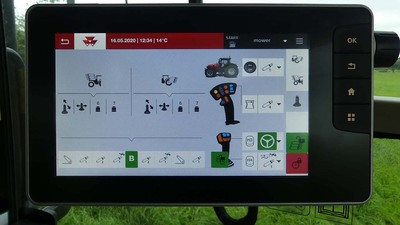
Contour Assist and Contour Segment are also new. The former allows you to do a job/run once without guidance; the tractor will then follow the path the tractor has just created, while Contour Segment creates infield waylines based on the boundary of the field.
As for button and control assignment, such as the 10 IsoBus functions, all this can done through the terminal. It is a straightforward process, but as discussed in the ‘cab evolution' panel, it is the physical limitations of the controls which hold this feature back and stop it from being something really useful, particularly for spool assignment. It is an area where the new 8S may take further.
Old favourites like MF's Dual Control are still present, offering an alternative to setting up a full blown headland management sequence, particularly for implements which require control over a two stage process such as a drill and a front press where one needs raising before the other. However, the headland management system is now so simple, Dual Control almost seems redundant.
Cleverly, the firm has duplicated various pages in several menus, which cuts down on going from one menu to the other when setting the tractor up. For instance, the page to assign functions to buttons appears on several menus such as the hydraulics and IsoBus menus, which is where you would logically want to assign buttons.
And once you have setup the tractor to a particular job or implement, profiles can be saved and recalled. The firm's Task Doc feature also allows information to be shared with the farm office via USB stick, Bluetooth or SIM card.
Cab evolution
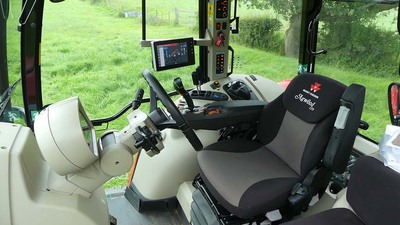
In the cab, it is more evolution than revolution, unlike the new 8S. You still get three specification levels; Essential, Efficient and Exclusive, which offer a wide choice of spec from simple mechanical spools and basic controls, right up to fully electric spools and more advanced control.
Both our test models came with the firm's popular middle spec level, Efficient, which offers the ability to really mix and match spec to how you like it. In our case, this saw a good mix of mechanical and electric spools fitted, plus the manufacturer's top-spec, multifunction control lever. The latter puts all of the tractor's primary controls to hand including transmission, shuttle, rear linkage, one spool, and headland management and pto activation. All the buttons can also be assigned IsoBus functions, if you have a compatible implement.
On our 7718 S model, the main lever was also accompanied by a secondary joystick, designed to mainly look after the front linkage and/or a loader's functions. Integrated into this are buttons to control the tractor's direction and gear changes. A further two buttons can be assigned a variety of functions such as a spool or headland management activation.
For further transmission control, the tractors are equipped as standard with the firm's famous left hand Power Control lever. More than just a shuttle lever, you can also make gear changes and ‘hold' it in neutral. It is great to use and has become a firm favourite of ours over the years, especially when compared to a lot of other bog standard shuttle levers on the market.
Cab evolution 2
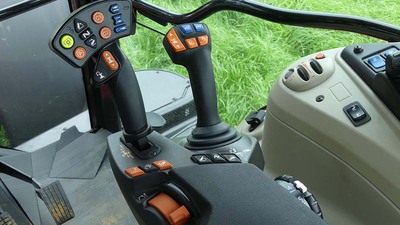
However, especially with the introduction of the new 8S range, controls are looking a bit long in the tooth, especially the top-spec multifunction lever. While you can assign IsoBus functions to its various buttons, the ability to only assign one spool means its functionality is a bit limited. For us, using a front and rear mower with the 7718 S, it would have been great to have control over two spools on the lever.
To get around this, we used the secondary joystick to control the front and rear mowers. But, its assignability is also limited, which meant the sideways action of the joystick had to look after the front mower, while the forward/backwards movement looked after the rear mower. While this is no big deal, in an ideal world this would be the other way around. However, its integrated transmission controls meant you did not have to lift your hand off the joystick.
To give an illusion that the cab looks cleaner, cab colours have had a fettle, which sees darker materials used for the seats and the armrest control area.
Comfort-wise, it is still a decent place to work. The steering wheel offers plenty of adjustment to get comfy and the front axle and cab suspension systems work well together. However, in-cab storage is a little bit lacking, with few places to put lunch boxes and drinks, and the air conditioning could do with being a bit more powerful.
External changes
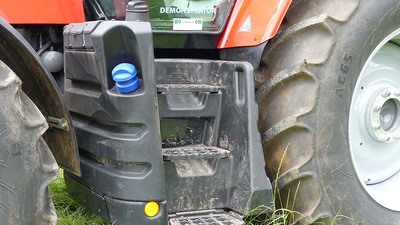
Though many of the major metal bits of the tractors are still the same - engine, transmission, front axles and rear-end, for example - the machines have undergone several nips and tucks. Mainly driven by safety and emission regulations, this includes the introduction of the firm's ‘S Effect' and Stage 5 emissions compliance.
Most visible changes are to the tractors' bonnet, which sees new aggressive family styling added, along with the new ‘S' designation. S models came into being about two years ago, when Mother Regulations forced tractor manufacturers to implement extra safety features. These included dual line brakes, a trailer air braking system, wide angle mirrors, extra side markers/lights and safer pto operation, to name a few.
More recently, Stage 5 compliance sees emissions controlled via a selective catalytic reduction and a diesel oxidation catalyst, as before, but now with the addition of a soot catalyst. The latter is said to be totally passive, requiring very little regeneration, so no parking up just to burn off particles.
All engine after treatment is taken care of in a canister near the right hand steps, with the large exhaust pillar of old now slimmed down for extra visibility. As a result, the battery has been moved behind the tweaked right hand steps for easier access, and the tractors have gone from the use of two batteries to one.
External changes 2
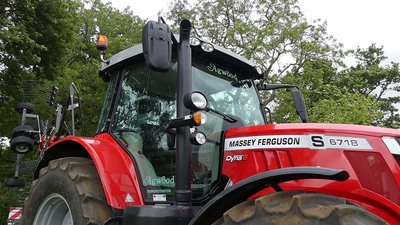
Rear mudguards have been altered to accommodate larger 42 inch wheels, or high profile 38 inch units, which also sees the fuel tank re-sculpted to fit the larger wheels. In addition, left hand steps have been redesigned, which are plastic and integrate into the recesses of the tank. They still offer plenty of foot space and lots of grip.
The slide out toolbox has also been moved from underneath the tank on the left hand side and integrated into the top of the tank. While it is a little bit smaller than before, it is now out of the way of mud flying up from the front tyres which is a bonus.
At the back, it is pretty much status quo, featuring the same layout, lift capacity and hydraulic pump options of 110, or 150 or 190l/min, depending on transmission option. Usefully, the rear lights can be programmed to come on when reverse is selected. A handy feature.
Up top, MF now partners with Trimble and NovAtel receivers. While Trimble is well known to us, the NovAtel was a new experience, but easily just as good as the Trimble. NovAtel's guidance experience is certainly extensive, too, which spans the shipping and aerospace industries.
Verdict
While the small evolutionary changes to the 6700 S and 7700 S Series are welcome, it is the massive leap forward in technology with the new fifth-generation terminals which really move these tractors on. The 67 and 77 have now finally got a terminal they deserve.
On top of the greater ease of use and improved functionality, the terminal choice also means spec levels are much more flexible, suiting everybody from lever lovers to technophiles. If anything, would a larger terminal option be good, allowing more information to be viewed without needing a second terminal?
As for the rest of the tractors, they seem to have aged well. The engine and transmission are certainly a good pairing. And with the launch of the new 8S, we know which way these are evolving too, with greater gear choice from the new Dyna-7 gearbox.
























